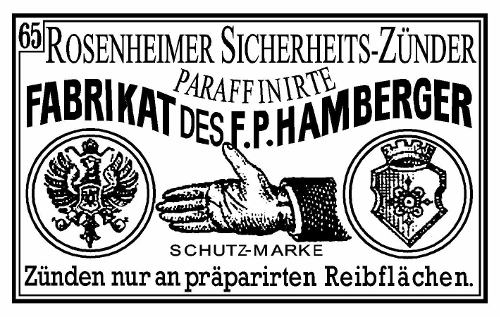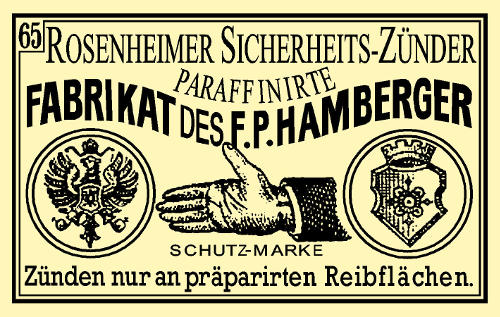Main Menu

Pocket Trash
One thing often ignored or overlooked in one's impression is the ephemera — the small details like what's in your pockets or stuffed into the cuff of your Bluse. Whipping out a modern lighter or cell phone, even if you think you are not being seen, is enough to blow even the best visual impression — or worse yet, being taken prisoner and having modern items discovered - this spoils this moment for both you and your captors — don't be that guy!
Below you will find just a small list of these little details you should pay attention to. Not all of these original items are available, but there are modern items that you can find, if you keep your eyes peeled, that can be substituted or adapted. Places like ebay, consignment shops, flea markets, yard sales, etc. can yield a wealth of these items — for often little payout. After spending a couple of grand for a top-notch impression, what's a few dollars more to raise your impression to the next level?
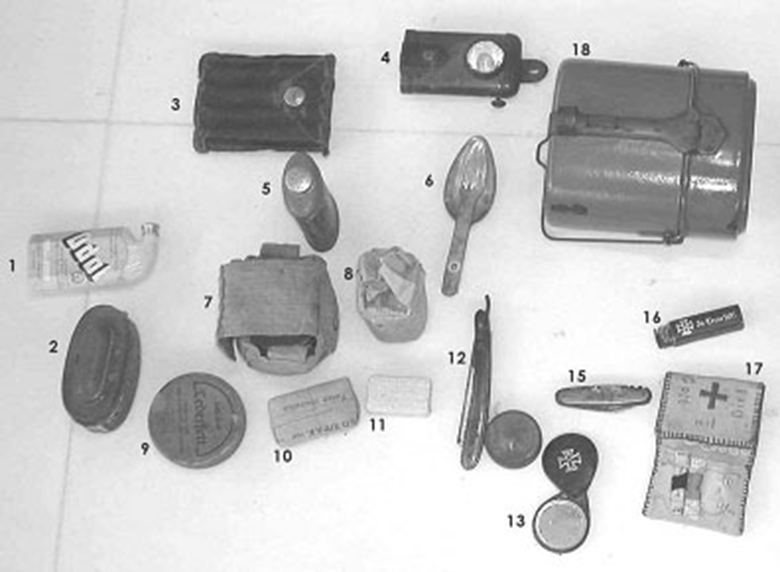
Photo courtesy of http://www.diggerhistory.info/images/equipment/german-kit.jpg
Photo above is shows the personal belongings of a WWI soldier we assume
after having been captured.
- An Odol bottle - this is a mouthwash/tooth cleaner, it is still available in a very similar container
- Tin, possibly for the soap, it has been suggested it is a Hindenburg-Armee-Feldkocher
- Leather case with snap closure, believe for cigars
- A flashlight
- This may be flea/lice powder can, or maybe delousing powder
- Spork (Eßbesteck)
- Spare gas mask filter carrier
- We think this is a package of tobacco
- Tin of "Lederfett" — leather conditioner
- Bandage roll
- Soap
- Straight razor
- Shaving mirror
- Not used
- Pocket knife (private purchase)
- Possibly a match case
- Sewing kit
Issued Items
Taschenlampe (Flashlight)
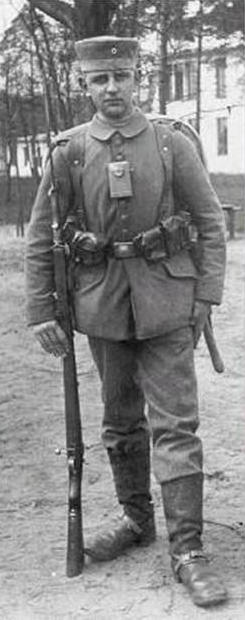 A dizzying array of flashlights were widely used by German troops during the war
and today they are still rather useful items to have when in a bunker
or in the field.
A dizzying array of flashlights were widely used by German troops during the war
and today they are still rather useful items to have when in a bunker
or in the field.
The most common type of Taschenlampe is a flat box-type flashlight with a single 4.5V bulb with reflector and round glass protective lens on the front with leather straps or a wire loop on the back to button it onto the tunic or greatcoat. Some were equipped with a blackout shield that would restrict the light beam to a minimum. There were numerous other configurations, including dynamo-driven flashlights that operated by squeezing a plunger, or pulling a string that wound up a magneto to produce power!
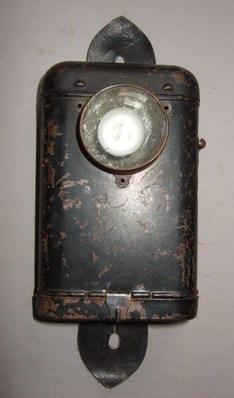
Left: A period photo of a young soldier with Taschenlampe buttoned to the front of his tunic.
Right: An original Taschenlampe.
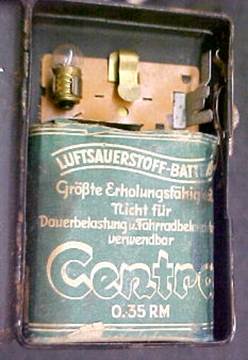
Left: An example of an original 4.5 Volt battery.
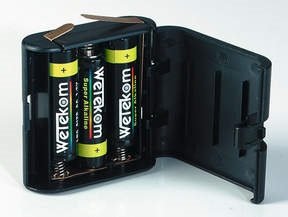
You may use an original WWI German Taschenlampe
or a pattern that closely resembles originals. Your Taschenlampe
may be modified to use standard U.S. batteries, but the easiest solution is to
pick up this little little device — this is a battery case that simulates the
original 4.5 volt batteries but it holds three standard AA batteries in series to produce 4.5 volts.
4.5 volt batteries are a standard European design and you will not find them on the shelves
in stores here, probably not even at places like Batteries Plus, but they can be found, they
are used in WWII German flashlights and you can find them from WWII reeancting suppliers.
Hey, take it up a notch and label that
battery
JR63 Battery Label Reproduction.
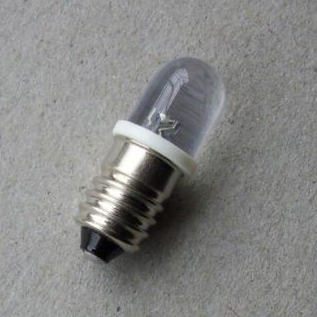
In the LED bulb era, screw in incandescent bulbs for these flashlights are
getting harder to find, not to mention that 4.5 volt bulbs were impossible to
find before anyway. However, you can now get 4.5 volt LED bulbs! They are
more impact resistant, FAR longer
lasting, and a single load of batteries will last a VERY long
time - cool huh? Just remember when shopping for these bulbs, you are
looking for a E10 base and be sure you get 4.5 volt. Ebay is a good place,
but LED E10 base bulbs will be found in 1.5-13 volts and come in multiple
colors - you will want "Warm White" — otherwise you might get the funky
harsh blueish LED light that will look
entirely out of place.
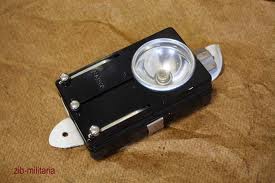
Most WWII German Taschenlampe
are not acceptable, as these most often include colored filters for
signaling — a feature not found in WWI period Taschenlampen.
However, some patterns of WWI German Taschenlampe did
have a single blackout shield that would slide into place and had a small hole to allow
just enough light through to read or see a watch face.
Field Dressing
 This is a bandage roll, every soldier was issued two - there is even a special pocket in the
tunic for this. They are not hard to make, but
Steve Fisher
makes a nice copy and sells them by the pair for a good price.
This is a bandage roll, every soldier was issued two - there is even a special pocket in the
tunic for this. They are not hard to make, but
Steve Fisher
makes a nice copy and sells them by the pair for a good price.
Soldbücher
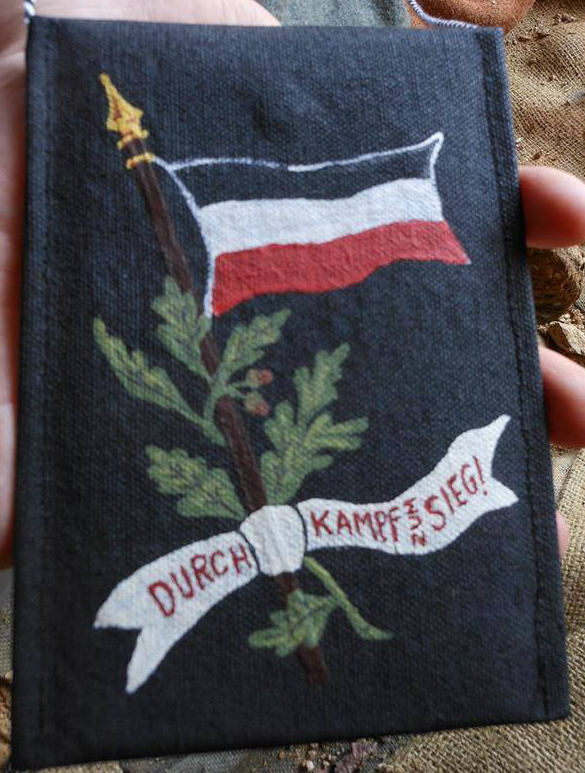
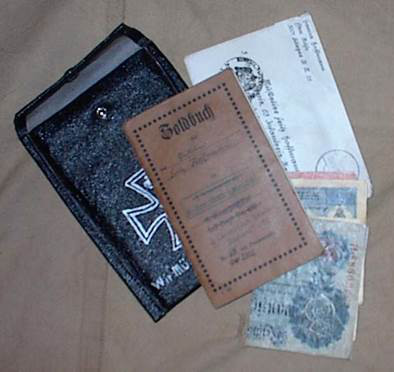
Soldbücher were issued to every soldier, typically in a cardboard
sleeve, but we're sure these didn't last to long. Therefore soldiers would purchase
their own wallets to hold their Soldbücher. These wallets
were constructed most often leather or oilcloth to help protect from moisture. Solder's
frequently painted patriotic images on these, and they would stuff these wallets with
letters, photos, and other papers into them alongside the Soldbuch.
Letters from home are not difficult - there are computer fonts called "Sütterlin" that mimic German handwriting at the time. Write yourself a letter, Google translate it into German (because Germans would have written to each other auf Deutsch), print it out and stuff it in an envelope addressed to your persona, and you're done! Add a period photo of a cute German Fräulein for that extra touch.
ID Disk Pouch

Identification Disks
Erkennungsmarke were issued to every soldier, typically with a neck
chord that typically twisted in colors representing the state (for IR63 this would
be the black and white of Prussia). However, pouches for these were private
purchase and typically made from leather or possibly oilcloth. Soldiers frequently
painted patriotic messages on them.
Mess Items
Eßbesteck (Spork/Easting Utensil)
German Soldaten were each issued with an Eßbesteck, a combination folding spoon/fork. The Eßbesteck was designed to be carried in the Kochgeschirr, but many Soldaten carried them in their pockets.

Original Eßbesteck
Fettbüchse (Butter Dish)
The Germans, in the Wilhelmine era, ate Schmaltz (seasoned goose fat preferably, or other animal fat) rather than butter. Therefore, when the Handbook of the German Army 1917 lists this item as "grease tin", it is a more accurate translation (Fettbüchse) than the often used collector/vendor term "butter dish."
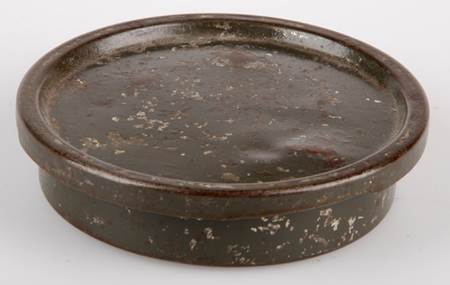
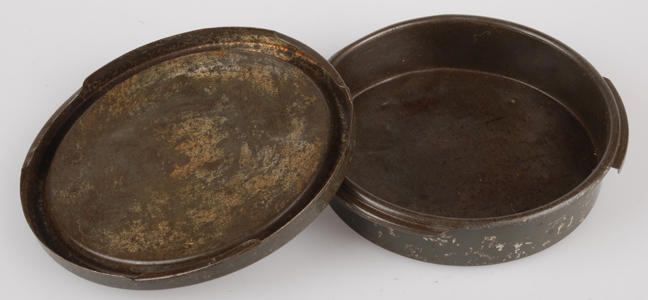
Original painted tin butter dish.

Original aluminum Fettbüchse w/ glass insert, dated 1917. You can see the wax seal on the inside lid that seals to the lip of the glass dish.
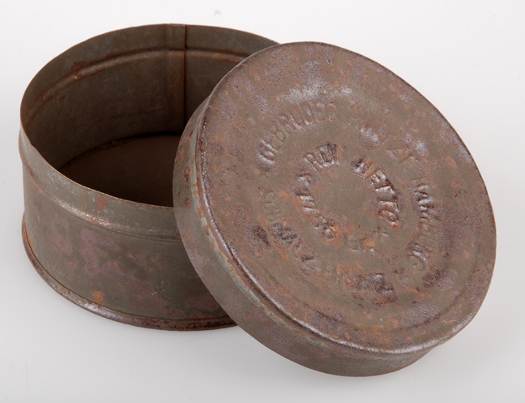
Original tin for Schmaltz.
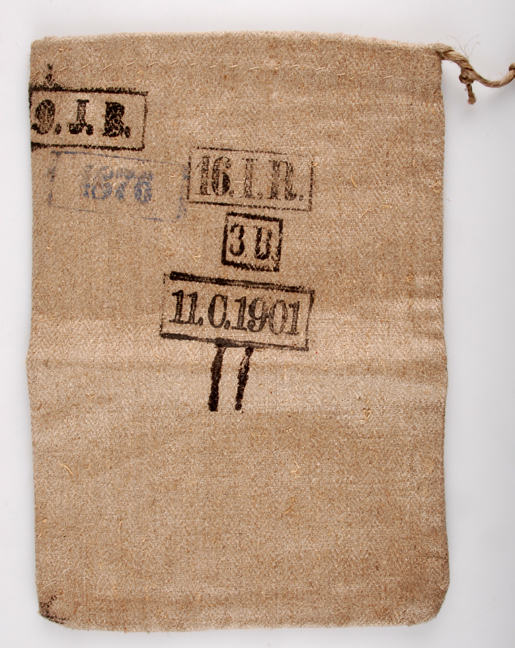
Original draw-string linen ration bag. Soldiers carried several of these for them to pack and store away their rations when they were distributed.
Smoking Related Items
Grabenfeuerzeug (Trench Lighter)
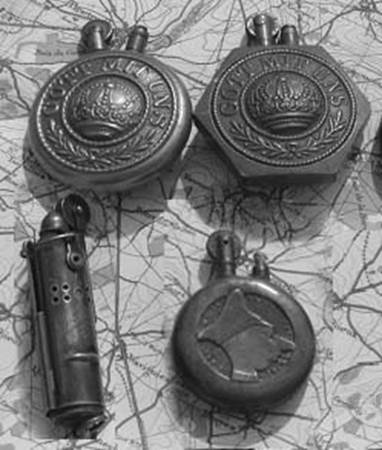
A very handy little item for those who smoke, no Bic lighters for
us. Pictured are a few varieties of lighters German Soldaten would have
carried, including a captured French lighter (lower right). Even if you
do not smoke, if you plan to throw some grenade simulators, they will
have to be lit, and you will need a period lighter.
Original usable lighters can be found, but reproductions are
available from time to time.
Cigarette holder and Match safe
Below are typical examples of a cigarette holder and match safe, both are brass, but tin was also common. The match safe carries the raised emblem from the Prussian belt buckle — the Imperial Crown with the motto "Gott mit Uns".
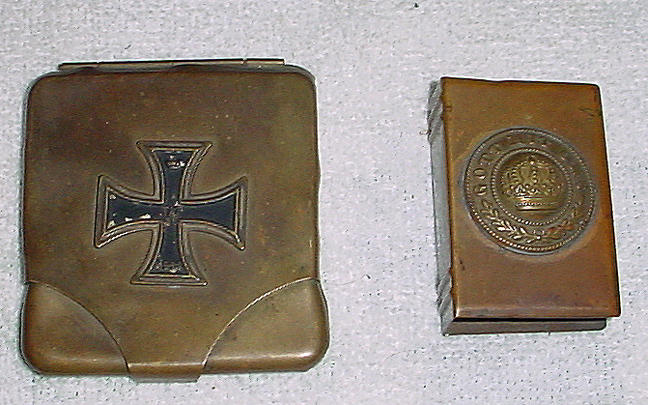
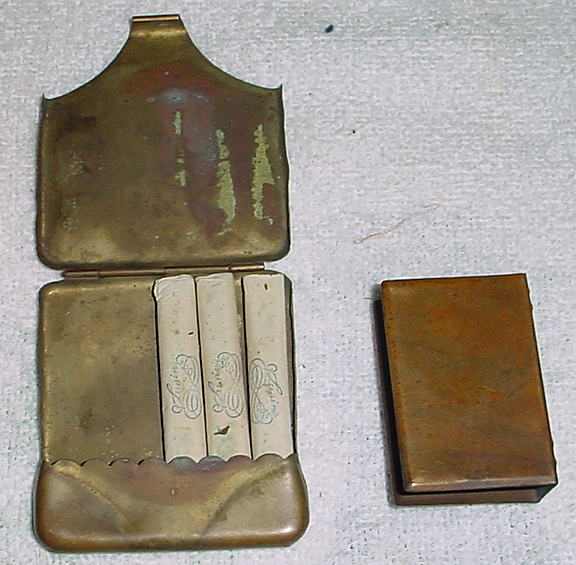
Carrying a generic pack of rolling papers and a pouch of tobacco and rolling
your own cigarettes is probably much easier than trying to reproduce a period
pack of cigarettes. Carrying pre-made cigarettes in a tin or brass cigarette
case is also going to be far easier.
Unfortunately we have not found an original German label for
cigarette rolling paper, but we do have a french one - you can re-label that
modern pack and just tell your Kameraden you took it from a lousy frog POW:
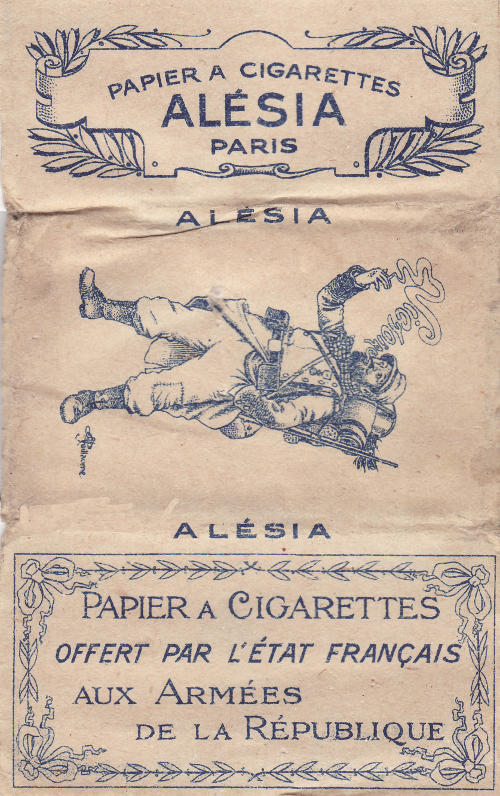
Now, if you just HAVE to have a pack of cigarettes, a popular
brand in Germany during the war and after was Pilot. Click on the image below to
download a PDF of a reproduction label to make your own pack:
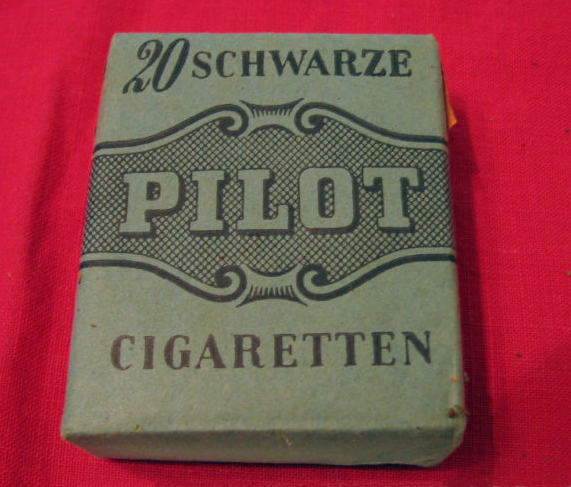
If you don't want the hassle of dealing with a lighter, lighter fluid, flints, etc. matches are an option. You can just buy a modern box of wood matchsticks, paper over the modern labels, or make a period label, and slip them into a match safe. Original brass and tin match safes are easily available, both original and reproduction.
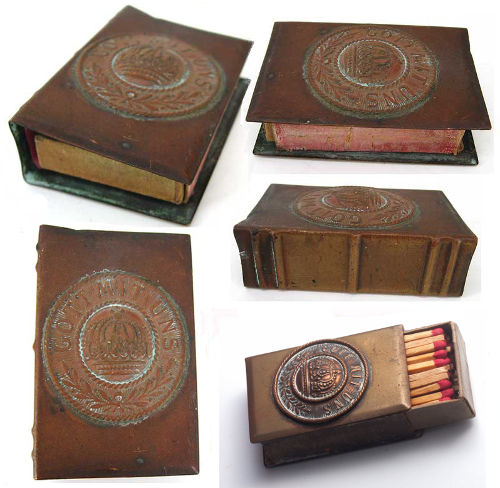
An original match safe with a box of matches.
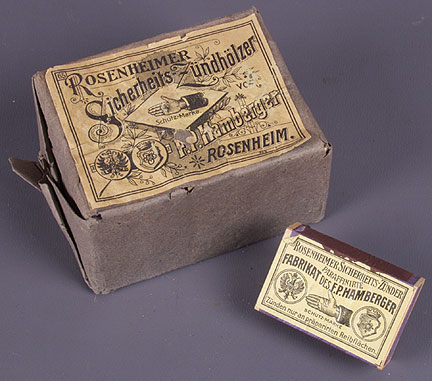
A box of match boxes and a single matchbox.
You can download an image of this matchbox label, in
yellow if you are using a color printer, or
white if you are printing to colored paper:
Pipes
Pipes were pretty popular for the period. Pipes came in many varieties and could be pretty impressive in design and construction. We would think that front line soldiers, if they did smoke pipes, would have used something small and simple.
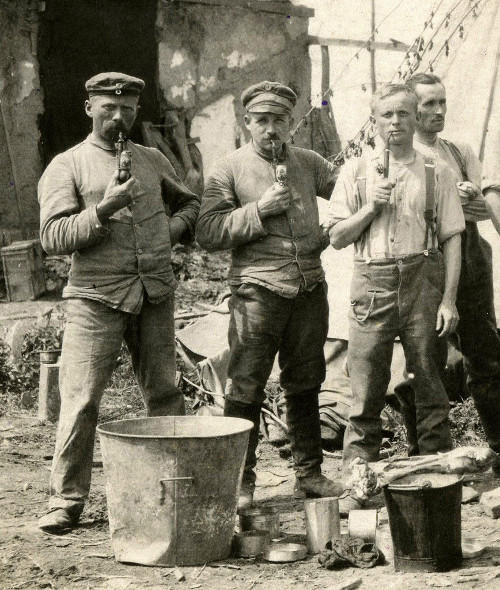
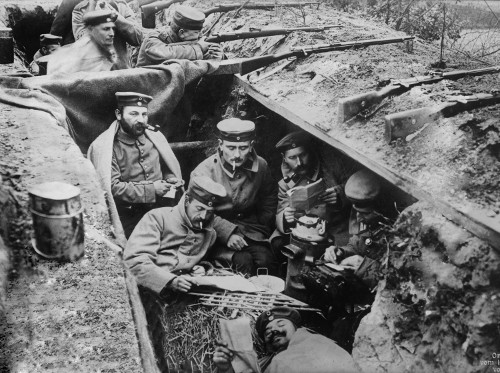
In the photo above left, the pipes being smoked are pretty elaborate - not really
practical for our combat events at Newville, we do not know the story behind the
photo but imagine these are support troops and not front line combat. In the
photo above right, the soldier in the center left of the photo is smoking a rather plain pipe.
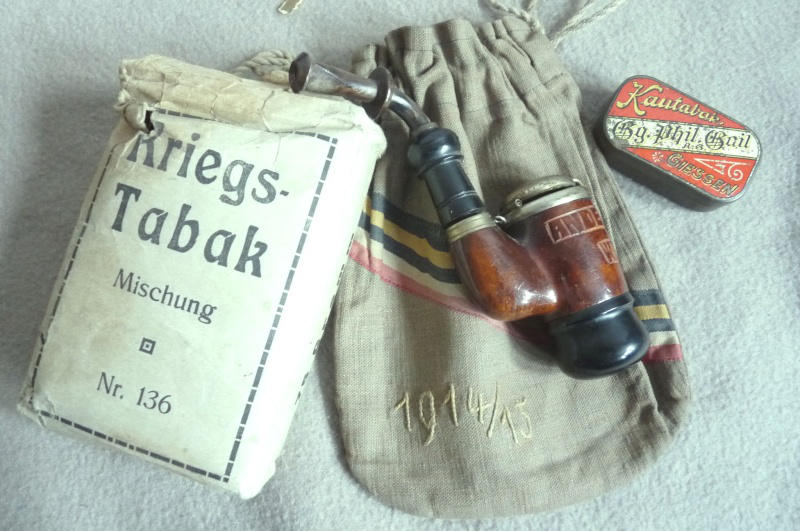
The above photo (courtesy of http://lagrandeguerre.cultureforum.net) shows a pipe, a private purchase canvas storage bag, a paper package of tobacco (as seen in the photo at the top of this page), and a small tin of chewing tobacco.
Personal Grooming Items
Razors
Soldiers HAD to keep clean-shaven in order for gas masks to seal properly - this is why beards, when worn, tended to be goatees. The common shaving method was the straight razor.
A period German straight razor.
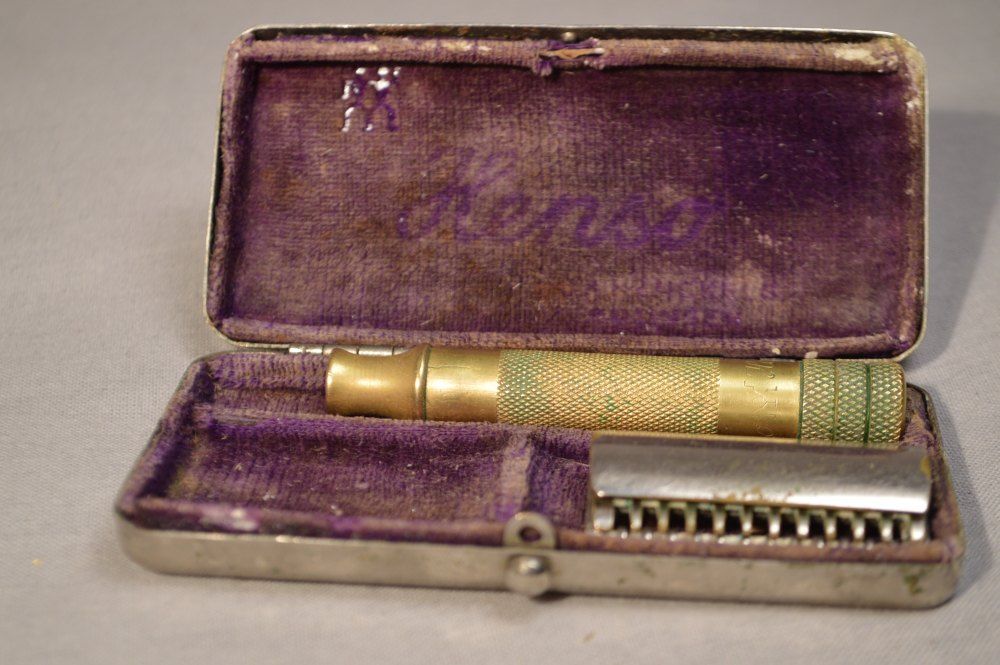
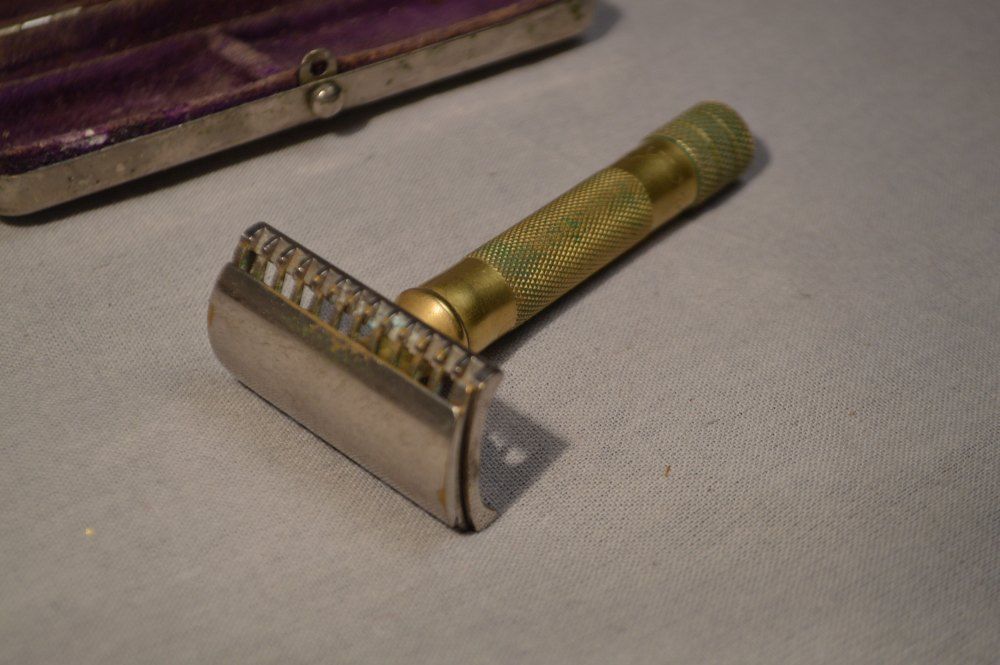
Mekur in Germany patented the safety razor prior to the start of the war, so these are an option, but
we suspect they would not have been available a mass numbers.
Hygiene
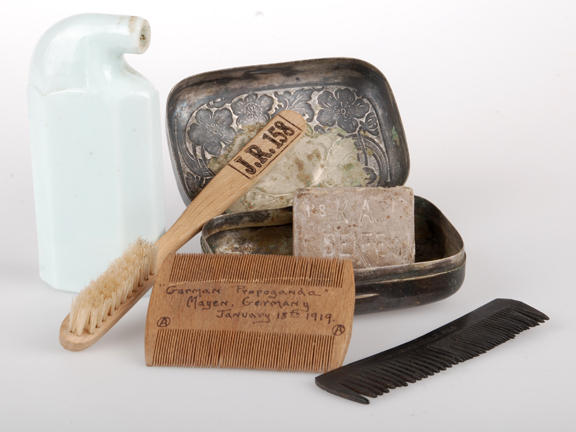
Just a "still life" shot of a soap tin, delousing comb, hair comb,
tooth brush and a
ceramic Odol mouth wash bottle.

Standard comb, can be made of wood, horn or bone.
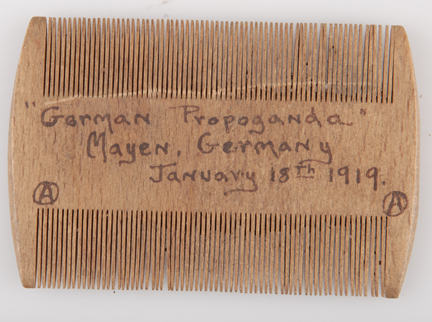
A delousing comb. You can still buy these nearly identical pattern in horn or bone from American Civil War vendors. We won't really need them, but lice were a BIG problem for the real soldiers so these were a commonly carried item.
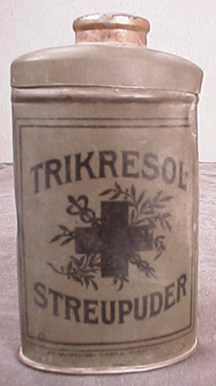
A canister of delousing powder.
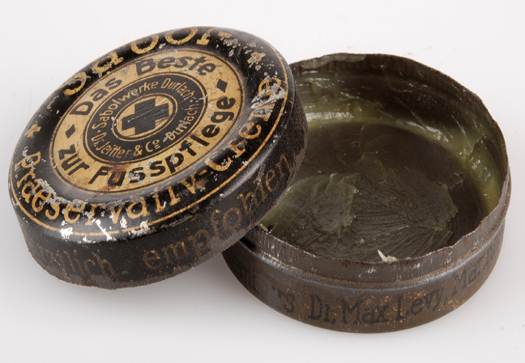
Original can of medicated foot creme.
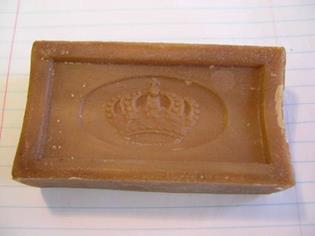
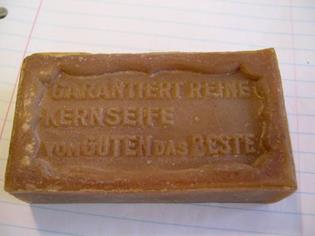
Front and rear view of an original issue bar of soap
Hold-all
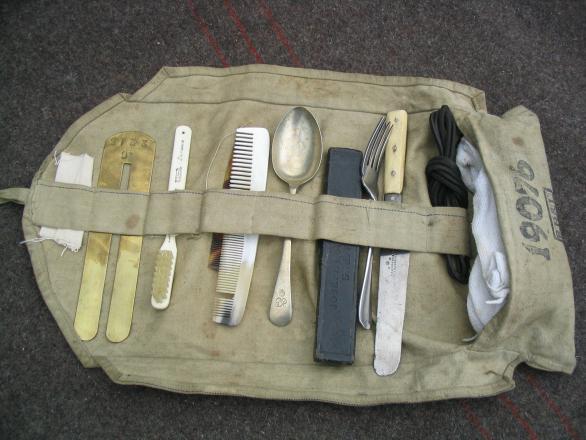 A "hold-all" is really a British item, and it is a simple canvas roll or bag where a soldier
stores his grooming supplies and other small items, like a sewing kit (housewife). Unlike
UK soldiers, German soldiers were not issued a "toiletry roll" or "hold-all". They were
issued only a bar of soap, a toothbrush, and
a towel. Most of their personal kit was made up of whatever they bought on
the civilian market — they were expected to be self reliant.
Apparently, many kit items sold on the civilian market were targeted for
the soldier-buyer. The soldiers were supposed to keep their personal
kit in a simple bag, stowed in the
Tornister.
When in
garrison, the items were supposed to be kept in a
wooden box, stored in their locker.
A "hold-all" is really a British item, and it is a simple canvas roll or bag where a soldier
stores his grooming supplies and other small items, like a sewing kit (housewife). Unlike
UK soldiers, German soldiers were not issued a "toiletry roll" or "hold-all". They were
issued only a bar of soap, a toothbrush, and
a towel. Most of their personal kit was made up of whatever they bought on
the civilian market — they were expected to be self reliant.
Apparently, many kit items sold on the civilian market were targeted for
the soldier-buyer. The soldiers were supposed to keep their personal
kit in a simple bag, stowed in the
Tornister.
When in
garrison, the items were supposed to be kept in a
wooden box, stored in their locker.
We assume that some sort of "hold-all" might have been available for private purchase and reproduction hold-alls for Germans are available — IR63 prefers those made by Steve Fisher.
German soldiers were expected to maintain their gear and uniforms, even at the front. It was common for them to carry a sewing kit or housewife Nähzeug.
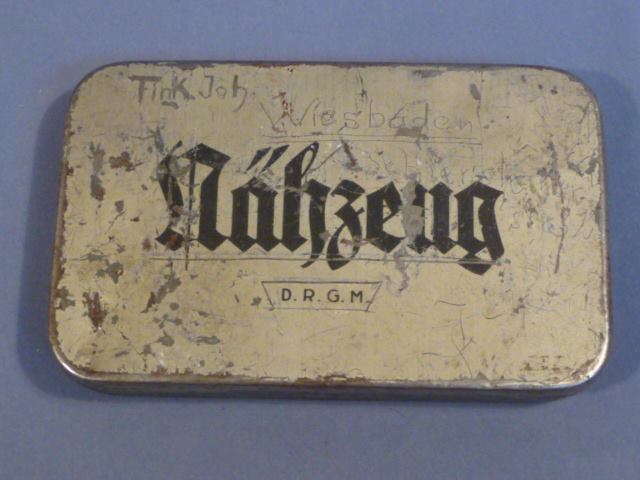
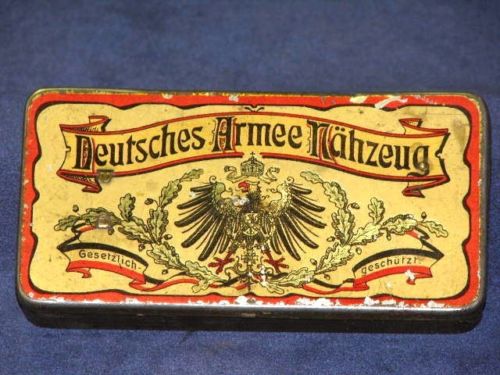
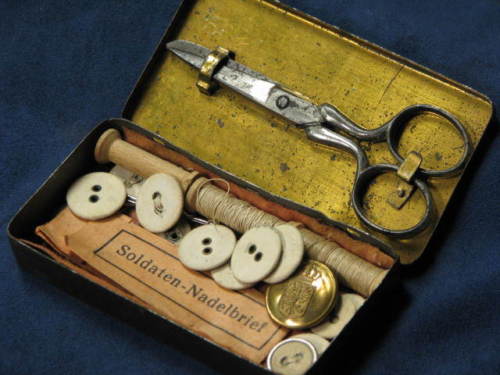
The above photos show sewing kits that are lithographed tins with sewing supplies and tools inside. But these were private purchase and would have been a variety of pouches, bags and tins. As reenactors engaging in mock combat and crawling around on the ground and running through trenches, you WILL rip you uniform and tear off buttons. Therefore, you should invest in extra buttons (of all the types found on your uniform), wool repair patches, threads, and needles, and you should find a suitable storage container. Like real soldiers, we have downtime during the combat and we should do just what they would have done and make field repairs.
Reproduction sewing kits for WWII and some original surplus military kits are available and can easily be adapted for our use. For simplicity, IR63 recommends those made by Steve Fisher.
Miscellaneous Items
Geld (Money)
Authentic Imperial era coins are readily available from most coin collectors, for no more than a dollar or two each, and when you are captured and searched, little things like a period coin or two really can add that extra touch that adds to the ambiance of the experience for those involved.
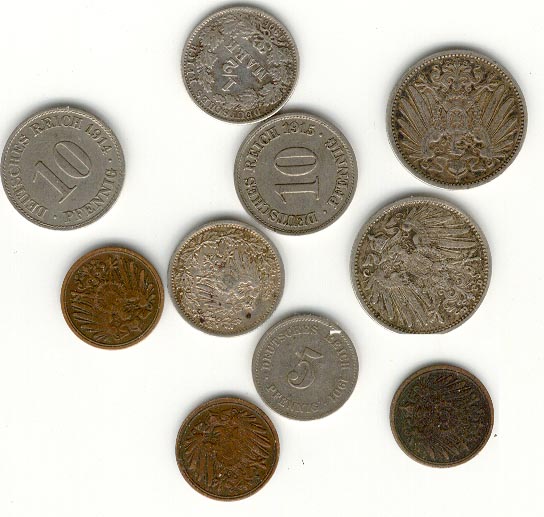
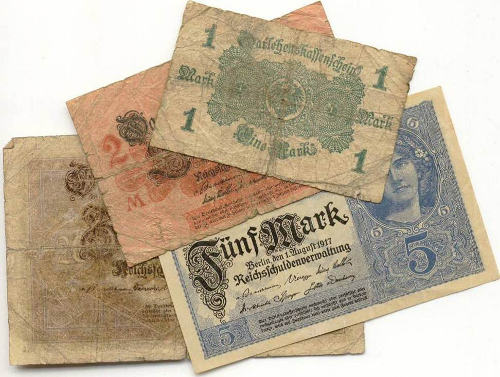
Paper bills can be copied from originals, no copyright problem here or legality issues like with trying to copy a current US dollar.
Files to print your own paper bills may be found on our "Downloads" page. We provide a few files for small currency, although you will find much larger denominations on other sites - just avoid these — soldier's most likely would have only have a couple of marks at most, having multiple hundred, five hundred and even thousand mark bills would be ridiculous and farby.
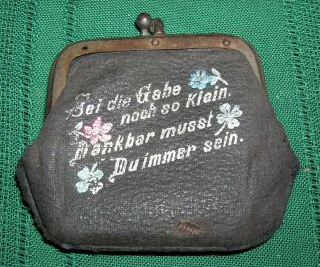
A soldier's coin purse with hand painted decoration - yes, back then men carried these.
Taschenmesser (Kat Knife)
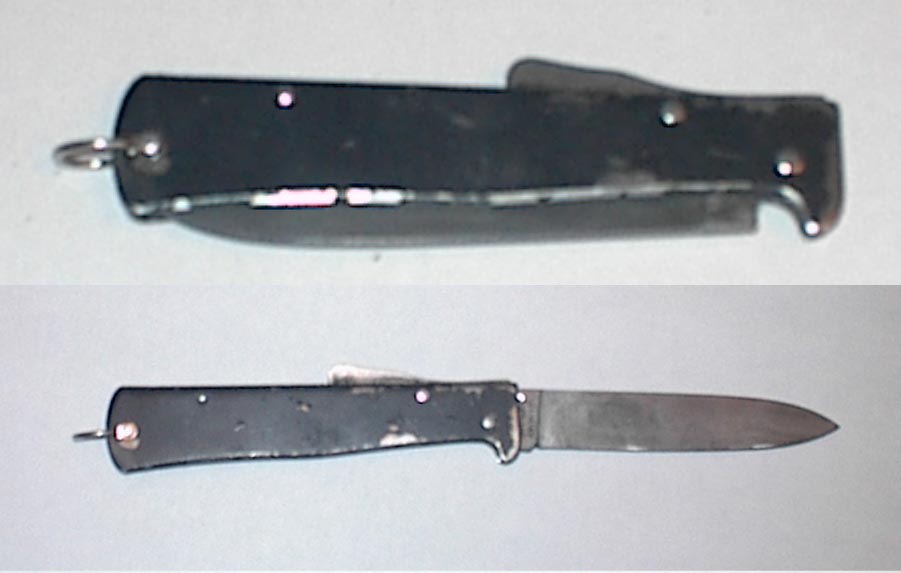
The Kat knife is simple, sturdy pocket knife with blackened steel grips and one locking blade. It is relatively light weight approximately 11cm in length and less than 1cm thick, making it easy to carry.
Reproduction Kat Knives are readily available, and still made in Germany and are nearly identical to those issued to German troops in WWI & WWII.
Pocket knives of the period, just as today, come in a dizzying array of sizes and patterns, and soldiers purchased their own, so as long as you stick to a period design, you will be safe.
Timepieces
Before wristwatches became popular in the 1920s, most watches were pocket watches, which often had covers and were carried in a special watch pocket and attached to a chain or fob. In the early 1900s, the wristwatch, originally called a wristlet, was reserved for women and considered more of a passing fad than a serious timepiece. Men, who carried pocket watches, were quoted as saying they would "sooner wear a skirt as wear a wristwatch". This changed in World War I, when soldiers on the battlefield found pocket watches to be impractical and attached their watches to their wrist by a cupped leather strap. It is also believed that Girard-Perregaux equipped the German Imperial Navy with wristwatches in a similar fashion as early as the 1880s, to be used while synchronizing naval attacks and firing artillery.
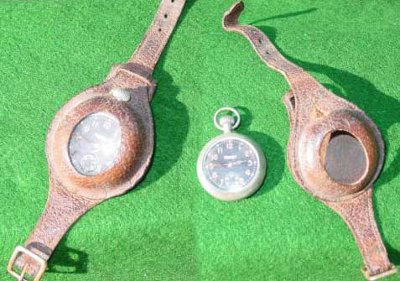
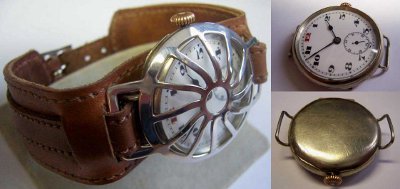
Pocket watches were the most common found in the trenches and are acceptable and encouraged for use by members of IR63 who wish to carry a watch (watches are not required). Try to find watches in silver or gold and of plain case. Dials should also be a simple one with either Roman or Arabic numerals.
If you must use a wristwatch, use a stitched leather band, in black or brown, with a cupped leather face protector or a perforated metal face protector.
Card Games
Skat is a 3-player trick-taking card game devised in early 19th-century Germany. It is the most popular card game in Germany and Silesia.
An original Skat deck circa 1892.
Skat cards are different than regular playing cards, there are fewer cards and different colors used. Modern Skat cards are usually based on French suits, and tournament decks are a hybrid of French/German suits, so if you plan to carry a deck you should do a little research.
Sadly, Skat is a complicated game that no one has seemed to get the hand of, and we have not discovered a simplified version we could even fake in the trenches.
